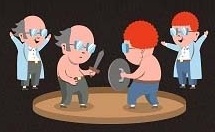My dear readers will recall, especially after their first cup of coffee for this morning, that their humble blogger once cracked a proverbial egg of wisdom for their review in the form of a multi-part blog-post on serious and willful misconduct. Well, that topic has seriously and willful reared its ugly head once more, this time in the form of an (unfortunately) unpublished Court of Appeal decision.
The CoA reversed the holdings of the Workers’ Compensation Appeals Board and the Workers’ Compensation Judge, holding that since “no substantial evidence of knowingly wrongful conduct on the part of [the defendant]” was to be found, the award must be annulled.
The case is that of Jorge Mora v. CLP Resources, Inc. Jorge Mora was a temp carpenter in the employ of CLP, who was sent out to a job site with a series of safety problems, including a table saw not secured to a table and with no safety guard on the saw. By the third week, Mr. Mora had attempted to report these safety issues to his temp agency (at least, according to his trial testimony, which appears to be in conflict with his deposition testimony) but was not able to report the specific safety problems.
Prior to his starting the job, a CLP safety inspector had been to the site, but had not noticed anything wrong.
Unfortunately, Mr. Mora lost his balance while working one day and placed his hand on the saw, sustaining cuts to his left hand.
In addition to his workers’ comp claim, the applicant sought increased benefits under Labor Code section 4553, alleging that CLP’s serious and willful misconduct was its willful failure to provide a safe place to work. At trial, the Workers’ Compensation Judge found that the testimony of a CLP witness as to the inspection of the work site was “questionable” and found that CLP had engaged in serious and willful misconduct when it failed to adequately inspect the jobsite.
In rejecting this finding, the CoA reasoned that 4553 requires the serious and willful misconduct to be on the part of an executive, managing officer, or general superintendent of the corporation. The CoA found that there was no findings (or evidence to support a finding) that CLP had specific knowledge of a dangerous condition – it’s inspection did not reveal it, and Mr. Mora’s comments were also vague enough so as not to put CLP on notice of the condition.
To sum up – the target in this case was the temp agency that did an inspection of the job site, found nothing wrong, and allowed its employees to go there. Hypothetically, the temp agency was negligent in how they inspected the site. And, come on folks, who inspects a factory when it is in “shut down” condition? Who inspects a construction site employing men using power tools when there are neither men nor power tools on the site at the moment?
That being said, negligence is not serious and willful misconduct. Remember, all those of you on the applicant side of the room, Labor Code section 4551 would serve to reduce the recovery of almost every single injured worker, as you could make a claim for employee negligence in almost every single workers’ comp claim (lifted with your back instead of your knees? That’s a Negligence. You weren’t holding the steering wheel at “10 and 2”? That’s a Negligence. Didn’t sit at your desk with proper posture? That’s a Negligence.
Now, here’s another fun thought: this is not the case where a worker blindly goes into a dangerous situation intentionally created by an evil employer. This is a case where a 13-15 year veteran of man’s war on wood (carpentry) was aware of a dangerous situation, knew it was dangerous, and should not have continued to work there. If CLP didn’t want to hear it, as he claims, he should have declined to willfully and intentionally place himself in harm’s way.
But he didn’t.
He was warned that work was hard to come by and he decided to willfully expose himself to a serious work condition where the likely result was his own harm.
If anything, CLP should have explored turning the Serious and Willful table (carpenters can make tables, right?) back on Mr. Mora.
Now, let’s take a sip of the reality Kool-Aid. No one will ask Mr. Mora what he did going back to that work place when he knew it was so unsafe, because he will explain “I needed the money” and everyone will understand.
Of course, when that same reason is given by an employer that can’t afford to buy workers’ compensation insurance, it is drowned out in the calls for the employer’s blood. After all, no one deserves more contempt or hatred in California’s workers’ compensation system than someone who tries to create jobs for his fellow Californians. (Please note, dear readers, your humble blogger is not advising you to violate the law or operate without workers’ compensation insurance. He is just commenting on the lack of sympathy a desperate small business owner receives as opposed to a desperate employee.)
Just a thought, dear readers, just a though.


